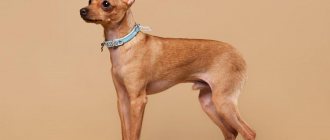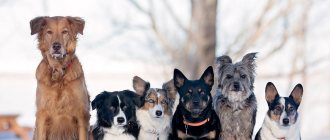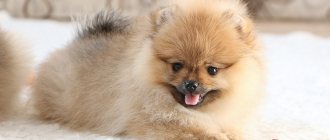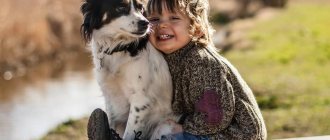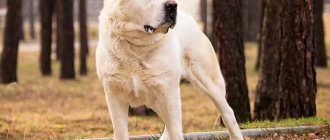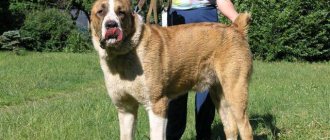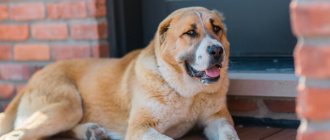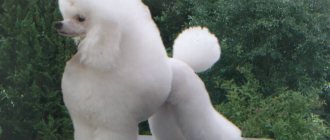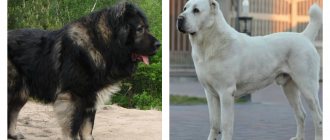Characteristics of puppies
What do they look like?
Most often, the auricle is located at eye level. The eyes are set wide, round, and small. The neck is strong. The paws are large, oval, with a powerful bone structure. The skeleton is massive. Well-developed muscles throughout the body, especially in the chest area. The dog is massive, but not prone to obesity. The weight of an adult Alabai ranges from 60 to 80 kg with a height of up to 80 cm. Typically, males are larger than females. The length of the dog is greater than the height at the withers. The tail is saber-shaped, most often docked. Wool up to 10 cm. Thick, hard, straight, with dense undercoat. The colors of Alabai are white, red, black, gray, brown, with evenly shaped tan marks. Sometimes there is a brindle color.
Alabai puppies (see photo below) , like adults, have a massive wide head and a flat forehead. The transition from the forehead to the muzzle is not clearly expressed. The head is slightly disproportionate: a heavy jaw without protruding lower incisors. The nose is large, with a black or brown pronounced nose. Alabai puppies have round, dark, widely spaced eyes.
The ears are triangular, small, low. Subsequently, the ears are cropped according to the standards adopted in a particular country. The body of Alabai puppies is solid and powerful. Short neck. Deep and wide chest. The back is wide and straight, the stomach is tucked, the croup is wide. Strong, large, oval-shaped paws. The coat of puppies is also coarse, straight and hard, with a thick undercoat.
Description by month
Newborn
A newborn alabai looks like a small oblong barrel weighing from 350 to 550 grams .
Monthly
By the month, the weight of the Alabai noticeably increases, by 3–5 kg, with a height at the withers of up to 30 cm.
Two month old
At two months, the Alabai’s height also remains within 30–35 cm, but its weight is actively changing. Babies during this period already weigh about 10 kg. Such a large weight gain is associated with the active formation of the puppies’ bone skeleton.
3 months
By three months, puppies grow up to 45 cm, weighing up to 20 kg .
4 months
This is a period of intense growth. The puppy's height is up to 55 cm, weight up to 30 kg . The puppy's body begins to change, becoming elongated and narrow.
5 months
At five months, intensive growth slows down briefly. At this time, the puppy may grow slightly, by 2–3 cm, and gain weight from 5 to 7 kg.
6 months
But from 6 months, Alabai begin to take on an appearance more similar to an adult. The body becomes wider, more powerful. Weight reaches 50 kg, height at withers up to 70 cm.
10 months
Alabai at 10 months is characterized by a significant increase in muscle tissue, which affects the appearance of the dog. The height of the animal reaches 75–80 cm and weighs from 60 to 70 kg.
1 year
By the age of one year, the height and weight of the alabai gradually becomes constant. Height reaches 80 cm, weight up to 70–80 kg.
Weight and height chart
| Age, months | Height, cm | Weight, kg | ||
| males | bitches | males | bitches | |
| 1 | 24–30 | 23–25 | 4,5–5,0 | 3,5–4,0 |
| 2 | 40–45 | 40–43 | 15–20 | 14–16 |
| 6 | 63–70 | 59–63 | 42–50 | 33–42 |
| 12 | 69–80 | 65–72 | 70–80 | 60–70 |
How old do they grow?
At what age can you keep a puppy outside in winter?
This is a rather controversial issue, and in each case it is worth considering the specific conditions. In any case, the puppy's transition to the street should not be stressful for him. Some breeders initially keep cubs and mothers outside, in enclosures. In this case, the issue of changing the environment is not so pressing. If the baby is under the protection of maternal warmth, then he tolerates external climatic conditions more comfortably. If the puppy has already been separated from its mother and is with people, then accustoming it to the street should be gradual and gentle.
In order to comfortably endure frost, a well-formed undercoat is necessary. Some owners keep puppies at home for up to 5–6 months.
Raising a healthy pet
In order for the puppy to grow healthy and strong, and for its parameters to meet the standard, you need to follow the recommendations of dog handlers.
- Feed your puppy good food. It can be dry, but it is advisable to soak it in warm water before use, but it can also be natural food. Before making a decision on how and what to feed the Alabai, it is better to consult a veterinarian.
- It is important that the food that the puppy eats is rich in vitamins, minerals and trace elements.
- It is necessary to have your dog examined by a doctor and get all vaccinations.
Remember, physical activity is very important for the Alabai, so you need to walk him and organize enough space for him.
For information about the characteristics of the Alabai dog breed, see the following video.
Alabai, Turkmen wolfhound, Central Asian shepherd dog - all these are names of the same breed of dog. Central Asians are not found very often; they are considered a kind of curiosity - Turkmenistan considers them the property of the country and does not allow them to be exported abroad.
Another name for the Alabai breed is the Turkmen Vokodav
The official classification of Turkmen wolfhounds occurred in 1993, and new standards were adopted in 2010.
Alabai puppies price
The price of puppies ranges from 30–50 thousand rubles.
How to choose an Alabai puppy?
- Number of individuals in the litter. More than five newborns - the risk of developing serious diseases in the future increases.
- Mother's age. The optimal age for the birth of healthy offspring is under 8 years of age.
- General appearance, activity. A healthy puppy is active, playful, and eats well. The coat is shiny, without bald spots, smooth to the touch.
- Compliance with the breed standard: characteristic scissor bite, wide head, flat forehead, oval paws. High tail, wide at the base. The wool is characterized by plushness and short length. This is what indicates the purebred puppy.
Girl
The girls are smaller in size. Girls are calmer, more pliable and flexible in character. They get along well even with small family members.
Boy
Alabai boys are active, stubborn, and prone to leadership. It is very important to start training your puppy on time and competently build your authority in the eyes of your pet. This will help you avoid behavior problems and other difficulties. Then the Alabai male will become the best protector and guard of the family.
With documents
If purebred breeding is a prerequisite for you, then having documents when purchasing a puppy provides significant guarantees of this. In addition, the presence of documents eliminates the risk of getting an animal with hereditary diseases, or simply a puppy with poor health .
Animal documents include: puppy card, veterinary passport .
The puppy card contains information about the puppy's name, the names of mom and dad, brand number, date of birth, name of the breeder and the name of the organization that issued the document. The veterinary passport records information about the puppy’s health and vaccinations.
Without documents
Most often, buying a baby without documents does not guarantee the purchase of an Alabai puppy. But there are also exceptions. For example, if mom and dad never had documents. This happens if the animals have not passed the breeding assessment, simply not reaching breeding age at the time of mating. But it is important to note that you can find a reliable and loyal friend even from among undocumented dogs. It all depends on which goal is more meaningful to you.
How much does it cost in Russia
In Russia, the price for a purebred Alabai starts from 15 thousand rubles and reaches 45–50 thousand rubles. But it can also be increased by the owners.
Abroad
Starting price from 1000 euros. This is the minimum below which purebreds cannot be sold. Above is at the discretion of the breeders. Plus, with a high probability, the costs of transporting and transporting the puppy will additionally fall on the shoulders of the buyer.
Cost of Turkmen Alabai puppies in their homeland
At home, the cost of a puppy starts from 30 thousand rubles. The upper ceiling is installed by the manufacturer. You should also be prepared to pay travel costs.
Does color affect the cost of CAO?
The value of the Alabai color does not officially vary. Rather, it depends on fashion. As of 2021, white alabai are popular. That is why you can find prices for them higher than for puppies of other colors.
With proper care, education, and love, a little puppy can grow into a real adult helper and friend. You should take a responsible approach to choosing your pet. It is important to remember a simple truth: we are responsible for those we have tamed.
vashkinolog.com
The largest representative of the breed
The largest Alabai in the world is considered to be a dog named Bulldozer. He lives in the Stavropol region. The weight of a representative of this breed is 130 kg, and his height, if he stands on his paws, is 2 m.
The dog has won many awards in completely different parts of the world. Despite its impressive size, the animal is balanced, calm and good-natured. Outside the ring, this dog has never bitten anyone in his entire life.
Note! Turkmen Alabais are attentive and noble dogs by nature. They never set themselves the goal of injuring the enemy, even during battle.
His owner could not even imagine that, by purchasing an Alabai dog, the height and weight of his pet would reach such indicators.
Factors such as genetics and regular training, as well as proper maintenance and nutrition, primarily helped the dog achieve success. The owner paid a lot of attention to his pet and provided regular exercise. Bulldozer won his first fight at the age of three.
Bulldozer - the largest Alabai
When growing Alabai, every owner of these amazing animals should know that they grow unevenly, and the statistics of height and weight are averaged. It is possible to raise a graceful, handsome puppy from a clumsy puppy only if he has good heredity, and also when he is provided with the necessary conditions of keeping and feeding. Regular physical activity is important. Only by observing all this can you raise a beautiful, healthy and large dog that will become an excellent guard and companion.
The Central Asian Shepherd Dog (CAO) is an ancient and large breed of Asian origin. In its homeland it is also known as the Turkmen alabai or wolfhound. Therefore, the Central Asian Shepherd Dog and Alabai are the names of the same animal.
The Alabai breed is one of the largest breeds in the world. These are strong, brave and noble dogs with pronounced guard instincts. They are capable of frightening the enemy with just their appearance. But the first impression is quite deceptive. With proper upbringing, the Alabai breed shows the best qualities - boundless devotion, good nature and balance.
Stages of dog development and growth
The duration of the puppy's growing up period can be divided into the following stages:
- Embryonic - the period when the puppy is in the womb. He develops not only physically (organs and systems are formed, the strength of the constitution and the foundations of health are laid), but also psychologically (remembers the smell of his mother, the foundations of his character and behavior are formed).
- The vegetative period lasts from birth until the eyes open (about 10 days). The puppy adapts to the surrounding world, smells, his body learns to adapt to temperature conditions. This is a period of active growth: puppies become 2 times heavier than at birth. At the same time, you can clearly distinguish between strong and weak puppies based on their activity. In order for weaker puppies to develop better, they need help finding their mother's nipple.
- Transitional - lasts until the ear canal completely opens (up to 2 weeks from birth, less often - up to 17 days). During this period, puppies begin to hear, stand on their paws, walk, and get out of the box to eliminate. To protect the puppies from injury, they are transferred to an enclosure with their mother.
- Adaptation - before reaching one month of age. At this stage, teeth erupt, the puppies begin to be supplemented with food, gradually weaning them from their mother's milk. Curiosity makes babies sniff, lick, and put everything in their mouth. Games are an important moment in the development of dogs; they begin at this stage; with their help, you can gradually accustom puppies to their owner.
- Socio-psychological – lasts up to 3 months. There is an active cognition of the surrounding world (people, objects, climatic conditions, street noises). The puppy is taught a name, a walk, a toilet, taught the concepts of “good” and “bad”, separated from its mother, this is the period of formation of a positive or negative impression of the environment. The owner needs to spend a lot of time with the dog, walking and training it. For normal development, the animal needs to move a lot and play (alone, with toys, with the owner, other animals). It is very important to protect the dogs’ psyche from severe fears during this period, because they remain in the memory. This is also the period when teeth are changed and vaccinations begin.
- Youth - up to 6.5 months. Typological characteristics of the animal’s behavior, including sexual behavior, are becoming established, so communication with people, other animals, and the surrounding world cannot be limited. Sexual games, which begin at this age, contribute to the formation of sexual behavior and determine the ability for normal mating. There may be problems with executing the “Come to me!” command. - Having noticed this, the owner should walk the dog on a leash. Growth gradually becomes slower.
- Final – up to 1–1.5 years. Permanent teeth grow, puberty occurs, females go into heat, males mark their territory. When among other dogs, the animal will try to take a higher rank position. The puppy may also try to take a dominant position in relation to the owner, which will then be difficult to change, so raising the puppy is of great importance.
- After this, the puppy becomes an adult, and by about 4 years of age, the animal reaches full maturity .
How old do dogs grow?
Intensive growth in dogs is observed until 6 months of age, then the rate decreases. The further development of healthy dogs kept in appropriate conditions depends on the breed and size. Let's look at the growth characteristics of small, medium and large dogs.
Small breeds
Small dog breeds include:
- Yorkshire Terrier - growth lasts up to 8–9 months.
- Pekingese - up to 9 months, sometimes up to 12 months.
- Chihuahuas grow in height for up to 8 months, then gain strength.
- Pug - up to 6 or up to 9 months with active weight gain.
- Toy terrier - up to 180 days.
- Toy poodle - growth continues until 7-8 months.
- Pomeranian Spitz - its growth ends at 6 months, after which the bones become stronger.
- Dachshund - up to 8 months in height, then gets stronger.
- Staffordshire Bull Terrier - up to 7 months, growth stops by 10-12 months.
- Shih Tzu - grows at 4-6 months.
Medium breeds
Medium breeds of dogs grow until about 12 months of age; in terms of breeds it looks like this:
- Spaniel - about 8 months, matures up to 1.5 years. Cocker Spaniel
- French bulldog - up to 8-9 months, then grows in breadth.
- Basset hound - up to 8-10 months, until about 15 months it gains muscle mass.
- Laika - up to about 9-10 months.
- Chow chow - up to 11 months.
- Husky - grows in height up to 1 year, in muscles - up to 1.5–2 years.
- Pit bull terrier - up to 9 months, the end of growth occurs up to 1.5 years.
- Cocker Spaniel - up to 8 months in height, fully formed at just over 12 months of age.
- Bull Terrier - grows in height up to 10 months; the appearance of an adult animal is formed up to 1.5 years.
- Golden Retriever - grows by 1 year, bones and muscle mass gain shape by 1.5 years.
Large (large) breeds
Large breeds take the longest to grow and by the age of 3 years they take on the appearance of an adult dog. The growth of large breed dogs is as follows:
- Rottweiler - grows in height up to 1 year, gets stronger up to 2 years.
- German Shepherd - growth occurs up to 1 year, muscle mass increases up to 2 years.
- Labrador Retriever - grows up to 1.5 years, fully matures up to 2.5 years.
- Saint Bernard - grows up to 12 months, by the age of 3 it gradually gains shape.
- Caucasian Shepherd Dog - growth in height occurs up to 1 year, formation of muscle mass - up to 2 years.
- Mastiff - grows up to 1 year, the exterior is formed up to 2.5 years.
- Irish Wolfhound - up to 1.5–2 years.
- Great Dane - at the withers it grows up to 1.5 years, in weight - up to 3.
- Moscow Watchdog - height growth stops at 14 months, sometimes at 1.5 years of age, formation stops at 3 years of age.
- Alabai - up to 1 year, gets stronger up to 3 years.
Varieties of the Central Asian Shepherd Dog breed
Along with the Caucasian Shepherd, the Alabai is a group of aboriginal dogs that lived over a vast territory. Animals developed in isolation from each other, so they have differences in appearance and temperament. The current standard does not reflect the entire variety of forms of the Central Asian Shepherd Dog.
Depending on the place of residence, the following types of Alabais are distinguished:
- Mountain is a massive long-haired Alabai. A low center of gravity allows him to maintain balance during mountain treks. It is distinguished by its independence, balance, and resistance to severe frosts.
- Steppe animals are light, dry and long-legged. Usually these Alabai are smooth-haired. They are more mobile, energetic and resilient. In some areas they are used as hunting dogs.
Important. Curly or excessively long hair is a serious fault, which indicates an admixture of other breeds.
The following varieties of alabai are known:
- Turkmen Alabai is the original species that laid the foundation for the breed. This is the largest species of all varieties of alabai, a classic representative of the Northern Okrug, which is used for guarding and grazing livestock. In Turkmenistan, alabai are recognized as a national treasure. They are prohibited from being exported from the country;
- Kazakh Alabay (Tobet) is a rather rare variety of Alabay. These animals are a little lighter and more resilient, perfectly adapted to long running. Their guard instinct is slightly less developed than that of the East European Shepherd (Oriental Shepherd);
- Armenian Alabai (Gampr) is a large, efficient dog with powerful jaws originally from the Armenian Highlands. Divided into long-haired and short-haired subtypes;
- Siberian Alabai is a cross between a German Shepherd and a Husky. The Siberian Alabai is distinguished by obedience, affection for people, and high intelligence;
- Tibetan Alabai is the result of crossing with the Tibetan Mastiff. Very rare species;
- Uzbek alabai (buri basar) is not as large as the classic SAO. It has a lighter build, an elongated body and an elongated muzzle.
Recently, a new variety has appeared - the Turkish Alabay, but there is no information about its breeding in Turkey. Therefore, the history of the appearance of these animals remains a mystery even to specialists. The Turkish Alabai still remains in the shadow of more popular guard and herding dogs.
A mini Alabai is considered a deviation from the norm. Most often these are mestizos, similar to the Central Asian Shepherd, but much smaller in size. Professional breeders reject such individuals, but amateurs often keep them as pets.
A wide range of Alabai colors - from white to black - applies to all varieties.
Important! Unscrupulous breeders sometimes sell breeding dogs, passing off puppies as a new variety of Central Asian Shepherd Dog. For example, American Alabay. In fact, such animals do not exist.
How to determine a dog's age
There are cases when the owner does not know the date of birth and age of his pet, and this indicator is important from the point of view of the start and frequency of vaccinations, sterilization, castration, training, care and feeding.
In order to approximately determine the age of an animal, there are the following methods:
- Look at the teeth . A young animal 1 year old has white, clean, healthy teeth, a 2-year-old has yellow teeth, a 3-5-year-old has tartar, a 6-year-old has worn fangs, concave incisors, and over 8 years old have blunt fangs. Old dogs' teeth begin to fall out. Teeth change between the ages of 2 and 6 months.
- Inspect the wool . The older the animal, the harder it feels to the touch. As you get older, your fur begins to turn grey.
- Touch and examine the muscles . Flaccid muscles are a sign of an aging animal. The older the dog gets, the less he moves and the more he sleeps.
- Look into your eyes . With age, the eyes begin to water and become dull, while the gaze of young dogs becomes clear.
Video: how to find out the age of a dog
